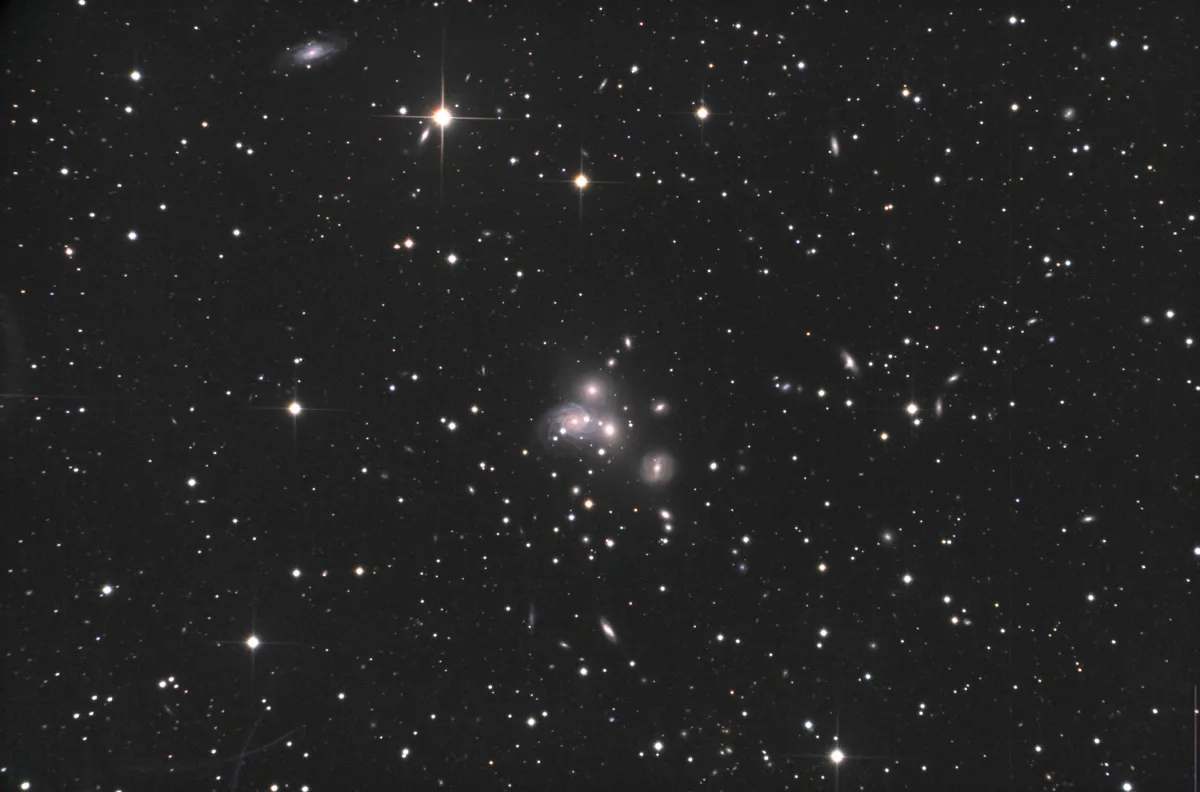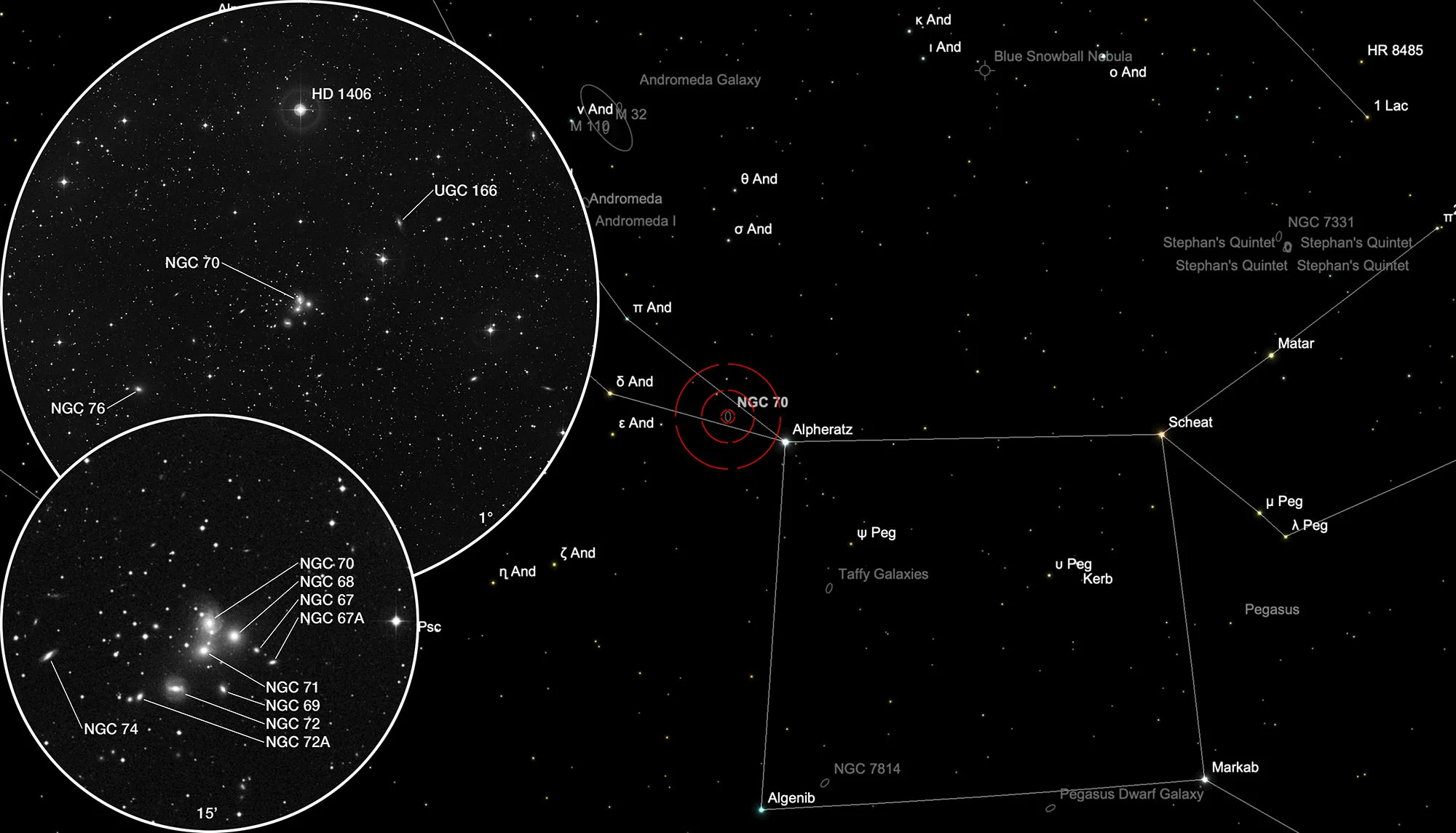NGC 70 Galaxy Group

History
On 11 September 1784 William Herschel found a «very large nebula» with his 18.7 inch reflector telescope that he logged as V. 16 and noted: «Extremely faint, 5 or 6' diameter.» [463] As the estimated diameter suggests, Herschel may have seen the merged light of NGC 68, 70, 71, 72 plus some of the stars in the vicinity, which appeared as a a bigger connected object. [204] John Herschel observed this nebula on 16 September 1828 (seep 178), listed it as number 15 in his «Slough Catalogue» and noted: «An extremely faint cluster with nebulosity, 5' diameter. Several stars 15...18m. Seen distinctly, but there is also unresolved nebulosity.» [466]
On 7 October 1855, RJ Mitchell, assistant to William Parsons, 3rd Earl von Rosse, directed the huge 72 inch reflector telescope at this group of galaxies and discovered other galaxies: NGC 67, NGC 69 and NGC 74. The somewhat remote galaxy NGC 76 had to wait until 22 September 1884 to be discovered by the French astronomer Guillaume Bigourdan with a 12.4 inch refractor telescope. His observation also led to IC 1539, a duplicate entry from NGC 70. [277]
Boris Aleksandrovich Vorontsov-Velyaminov lists this group of galaxies in his «Atlas and Catalog of Interacting Galaxies» published in 1959 as VV 166. [432] In Halton Arps' 1966 published «Atlas of Peculiar Galaxies» it is listed under Arp 113 as closely related and interfering spiral galaxies. [199]
Physical Properties
NGC 70 belongs to a compact group of seven or eight galaxies and shows similarities to Stephan's Quintet (HCG 92) in the neighboring constellation Pegasus. NGC 68 shows a smaller redshift than the other galaxies in the group and also shows no gravitational changes. It is probably not one of them and is in the foreground. [433, 434] However, a more modern analysis of SDSS DR12 lists NGC 68 as member of the MLCG 1437 galaxy group. [562] The distance of the group to the Milky Way is around 90 Mpc to 96 Mpc. [145]
This group of galaxies is often called the «VV 166 Group». Some also refer to it as the «NGC 70 Group» because NGC 70 is the largest member, others refer to it as the «NGC 68 Group» because NGC 68 is the brightest member. As true gravitational membership of NGC 68 to that group is not certain, the designation «NGC 70 Group» seems hence to be more accurate.
| Name | RA | Dec | Type | bMag | vMag | B-V | SB | Dim | PA | z | D(z) | Dreyer Description | Identification, Remarks |
|---|---|---|---|---|---|---|---|---|---|---|---|---|---|
| NGC 67 | 00 18 14.9 | +30 03 48 | Gx (E3) | 15.2 | 14.2 | 1.0 | 11.5 | 0.3 × 0.2 | 51 | 0.022162 | 93.61 | eF, vS, R | GC 32; MCG 5-1-64; CGCG 499-104; ARAK 4; Arp 113; VV 166 |
| NGC 67 A | 00 18 12.1 | +30 03 19 | Gx (E5) | 15.7 | 14.7 | 1.0 | 12.0 | 0.4 × 0.2 | 100 | 0.020734 | 87.58 | eF, vS, R | GC 32; Arp 113; VV 166 |
| NGC 68 | 00 18 18.2 | +30 04 21 | Gx (E-S0) | 13.9 | 12.9 | 1.0 | 13.0 | 1.2 × 1.1 | 0 | 0.019130 | 80.80 | eF, L, 3 or 4 st + neb | WH V 16; h 15; GC 31; UGC 170; MCG 5-1-65; CGCG 499-106; Arp 113; VV 166; IRAS 00157+2947 |
| NGC 69 | 00 18 20.4 | +30 02 26 | Gx (E/SB0) | 15.8 | 14.7 | 1.1 | 14.1 | 0.5 × 0.3 | 33 | 0.022285 | 94.13 | eF, vS, R | GC 33; MCG 5-1-66; CGCG 499-105; ARAK 5; Arp 113; VV 166; NPM1G +29.0011 |
| NGC 70 | 00 18 22.4 | +30 04 44 | Gx (Sbc) | 14.3 | 13.5 | 0.8 | 13.9 | 1.6 × 1.4 | 0 | 0.023907 | 100.9 | eF, vS, R, bet 2 F st | WH V 16; GC 34; IC 1539; UGC 174; MCG 5-1-67; CGCG 499-108; Arp 113; VV 166 |
| NGC 71 | 00 18 23.5 | +30 03 47 | Gx (E-S0/P) | 14.2 | 13.2 | 1.0 | 13.4 | 1.2 × 0.9 | 129 | 0.022339 | 94.36 | eF, vS, R | WH V 16; GC 35; UGC 173; MCG 5-1-68; CGCG 499-107; Arp 113; VV 166 |
| NGC 72 | 00 18 28.4 | +30 02 26 | Gx (SBab) | 14.5 | 13.5 | 1.0 | 13.4 | 1.1 × 0.9 | 15 | 0.024213 | 102.2 | eF, vS, R | WH V 16; GC 36; UGC 176; MCG 5-1-69; CGCG 499-109; Arp 113; VV 166 |
| NGC 72 A | 00 18 34.3 | +30 02 10 | Gx (E3) | 15.7 | 14.7 | 1.0 | 12.0 | 0.3 × 0.3 | 0.022399 | 94.61 | eF, vS, R | WH V 16; GC 36; MCG 5-1-70; CGCG 499-110; ARAK 6; VV 166 | |
| NGC 74 | 00 18 49.5 | +30 03 41 | Gx (Sb) | 15.6 | 14.8 | 0.8 | 13.1 | 0.8 × 0.3 | 131 | 0.023646 | 99.88 | eF, S, E, last of 6 | GC 37; MCG 5-1-71 |
| NGC 76 | 00 19 37.7 | +29 56 03 | Gx (C) | 14.1 | 13.1 | 1.0 | 12.8 | 1 × 0.9 | 65 | 0.024440 | 103.2 | vF, S, bM | UGC 185; MCG 5-1-72; CGCG 499-111 |
| IC 1539 | 00 18 22.4 | +30 04 44 | dup | 14.3 | 13.5 | 0.8 | 13.9 | 1.6 × 1.4 | 0 | 0.023907 | 100.9 | eF, bet 2 st 13 | NGC 70; UGC 174; MCG 5-1-67; CGCG 499-108; Arp 113; VV 166 |
Finder Chart
The NGC 70 galaxy group is located in the constellation Andromeda. On 29 September it is in opposition to the Sun and crosses the meridian at local midnight. The best observation time is May to February, when it is highest at night.
Visual Observation
320 mm Aperture: Of the galaxy group around NGC 70, which counts 8 to 10 galaxies, only the four bright ones were easy to identify with the 12.5" Dobsonian. They were NGC 68, NGC 70, NGC 71 and NGC 72. The other much fainter galaxies are then challenges for a larger Dobsonian. — 12.5" f/4.5 Ninja-Dobsonian, Glaubenberg, 2. 8. 2022, Eduard von Bergen
